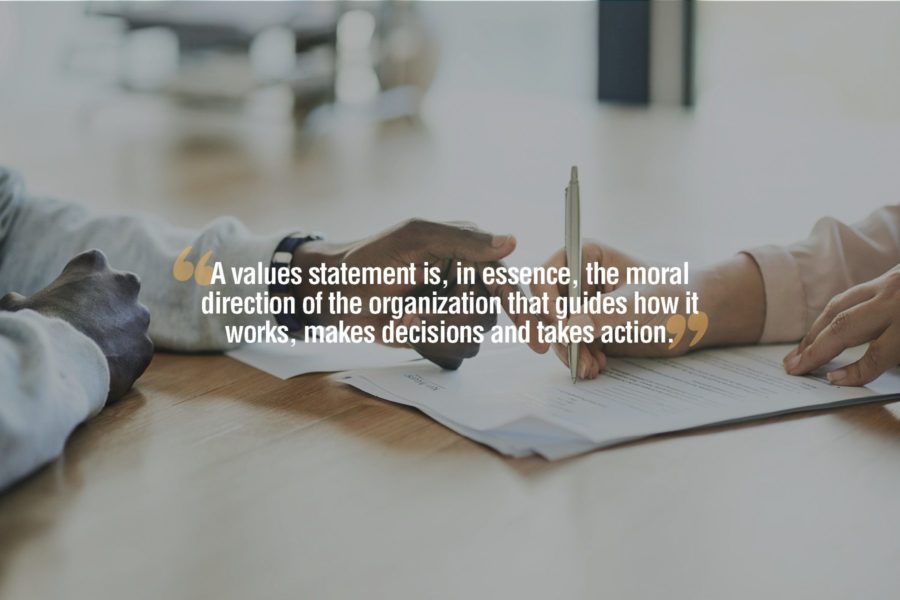What is a Values Statement?
Values statements, or value statements, are the core, guiding principles of an organization; they define what a company believes in and how people in the organization are expected to behave—with each other, customers, vendors and other stakeholders.
A values statement is, in essence, the moral direction of the organization that guides how it works, makes decisions and takes action.
Who Needs a Values Statement?
It doesn’t matter the size of your organization; all businesses big and small can benefit from a values statement.
For large companies, it helps establish a personality and enables employees to unite around common themes by establishing a baseline for a company’s culture. Smaller companies’ values may center around the founders and their reasons for starting the business. Their statements might be more direct and targeted toward a smaller customer base.
No matter what the size of your organization, a values statement helps give people a sense of who you are and what’s important to you.
What is the difference between a mission, vision and values statement?
It’s easy to confuse a values statement with a mission statement and vision statement, but they reflect three very different aspects of who you are as a business.
- Mission statements explain why your organization exists – why it was created in the first place. Was it to help the community? Provide a service? Fulfill an unmet need? The mission statement supports the vision and values statement and serves to communicate purpose and direction to employee team members, customers and stakeholders.
- Vision statements are forward-looking statements that state what an organization is striving to achieve. This statement can include a problem the business is trying to solve or a synopsis of a company’s strategic plan. The vision statement should inspire current and prospective employees and customers by showing its aspirations as an organization.
- Values statements explain what’s important to your organization, how you conduct business and how you conduct yourselves. They are a guideline that helps demonstrate the type of company culture you have and helps establish your brand reputation.
Benefits of a Values Statement
A values statement is more than just information to fill the “About Us” page on your website. It’s a key component of your organization and the company culture it builds. Some of the benefits of a values statement include:
- Shapes Your Company Culture: While a mission and vision statement explain purpose and goals, a values statement explains a company’s moral compass. A values statement reflects what your business stands for and gives team members – and prospective employees – a baseline of expectations for how to conduct themselves.
- Shows Transparency: A survey by Glassdoor showed that 90 percent of job seekers find transparency an important quality in an organization. Being honest and open in your values statement shows that your company is more an “open door policy” than “behind closed doors” kind of business and encourages team members to follow suit.
- Helps With Recruitment: A clear and honest values statement will catch the eye of those interested in working for your company, especially if it encapsulates the principles that are important to you and gives prospective employees an understanding of the type of environment in which they would work.
- Can Increase Business: A values statement shows what your business stands for, and a good values statement can set you apart from the competition. A company that embodies its values statement is more likely to have longer-lasting relationships with its employees and customers.
Establishing a List of Values
If you talk to some companies, you may be surprised at how long of a process writing a values statement can be. The first step is to gather a list of key words and phrases that describe your organization.
This step should be more than just some of your leadership sitting in a room brainstorming. Reaching out to the various departments, branch offices and teams for their input can assist greatly with your decision making. When doing this, ask questions such as:
- What are some qualities that come to mind when you think of your business?
- Why are those words important in the context of what you do?
- What are some qualities that separate your company from the competition?
- What kind of reputation do you have – or are you striving for – not only with your customers, but within the community?
- What qualities are important to your employees, and how does the company try to embody those qualities?
- What comes to mind when you think of a values statement?
Once you start to see some commonalities in certain words and phrases, you’ll be able narrow down the list to a manageable set of core attributes to work with to develop your statement.
What are examples of values?
It’s easy to get lost in buzzwords when writing about your company, but it’s important to start somewhere. Establishing your values statement is a process; but it will be beneficial to your company’s presence and reputation long term.
When you’re starting to write down potential values, make sure they’re traits you can explain and provide examples of when asked, and that they truly represent who you are as a company; not necessarily what you wish you were.
Here is a list of traits that may help jump start your values statement brainstorming session. If some of these resonate with you, discuss them with your team and flesh out how they align with your company’s practices, principles and strategic plan.
- Accountable
- Adaptable
- Agile
- Approachable
- Capable
- Collaborative
- Committed
- Creative
- Craftsmanship
- Customer-focused
- Diverse
- Efficient
- Entrepreneurial
- Ethical
- Fair
- Family-oriented
- Flexible
- Generous
- Honest
- Inclusive
- Innovative
- Integrity
- Modern
- Respectful
- Responsible
- Responsive
- Secure
- Socially responsible
- Sustainable
- Transparent
Narrowing Down the List
Once you have your short list of words and phrases, you’ll start to see some commonalities emerge. Some words will show up more than others, and a common theme may become more apparent. At this point, note these values and discuss how they fit in and align with your company’s goals.
Ensure that if they appear in your values statement, you can back them up through your company culture, which can include training, internal and external communications and the establishment of your brand.
When you have a draft of your values statement, circulate it among leadership, key employees and even trusted customers and/or service providers. Often what one group sees is not as evident to another.
Again, values statements should reflect what the company holds to be true, not what it wishes it did. You may need to tweak the statement here and there until you come up with a polished version that has a majority consensus.
Next Steps
- Communicate: Just like your mission statement and vision statement, it’s important that your values statement do more than just live on your website or in your marketing materials.
- Share With Employees: First and foremost, employees need to be educated on not only what your core values are, but ways to embody them. Communicate with your employees to explain and educate them about your values and how they can take steps to embody them in their daily work. Consider including your values statement, depending on length, at the bottom of emails, internal newsletters or company intranet. When sending leadership communications, include references to how the company continues to reflect these values. Talk about your values in company meetings and employee town halls, and tie them back to your strategic plans and goals.
- Share With the World: One of the goals of a values statement is to have it become a describer of your organization when people talk about it. If “integrity” is one of your values, then you would hope that integrity is a word that comes up when someone mentions your company. Ensure your values are prominently displayed on your website, marketing materials and any other ways you have of promoting your business. Reference your values in communications, and show examples of how your company is embodying them.
Upholding Your Values Statement
A values statement is only as good as the actions behind it.
Live the Values
If you’re not doing so already, ensure that you and your team are integrating your values into everyday processes.
If a core value is efficiency, make sure that strategies and workflows are in place to uphold this value. If you value innovation, make a point to show initiatives related to your innovation goals.
Ensure management is reflecting your organization’s values statement on a daily basis and that these individuals are working with their teams to do the same.
When interviewing prospective employees, ask questions that relate to values to ensure these individuals will fit in with your business culture. When onboarding employees, offer training and give examples of ways they can live the values in their everyday work.
Solicit Ongoing Feedback
Solicit feedback from employees and customers as to their satisfaction with your business based on its values statement. You might find you are succeeding in some areas and needing improvement in others.
At some future time, you may even find you need to amend your values statement based on how your company grows and changes.
However, it’s important not to drastically change your company values or revise them too often. A values statement is the foundation of what an organization believes and stands for; revising it continually will cause you to lose credibility and authenticity, potentially affecting your business success.
Recognition
Finally, recognize employees who are serving as examples of your company values. This not only helps with employee morale and an overall positive company culture, it reminds other employees and provides incentive to work harder to live up to those values as well.
You can also consider highlighting some of your partners or customers who align with your values. This can help nurture deeper, more longstanding relationships and show other potential clients the benefits of working with your organization.
A values statement for many organizations can become to be known as the identity of their brand. Some call a values statement the “soul” or “heart” of a company; others refer to it as their statement of ethics or beliefs.
No matter what you call it, a successful values statement can serve as an important guideline for employees, customers, partners and the general public to understand who you are, what you stand for and what’s important to you as an organization.
Learn how Higginbotham’s values shape our business and speak to a values-driven insurance specialist for personalized assistance.





